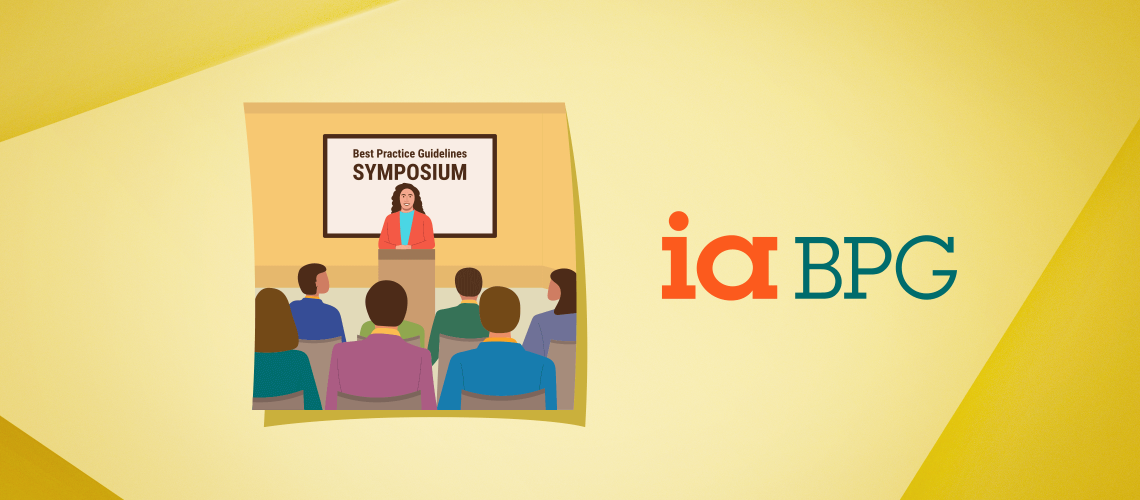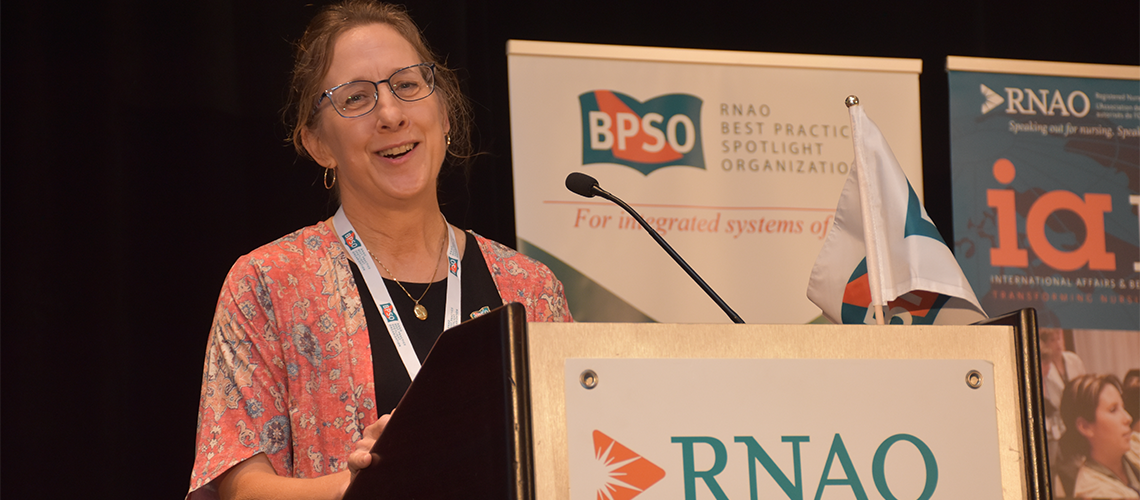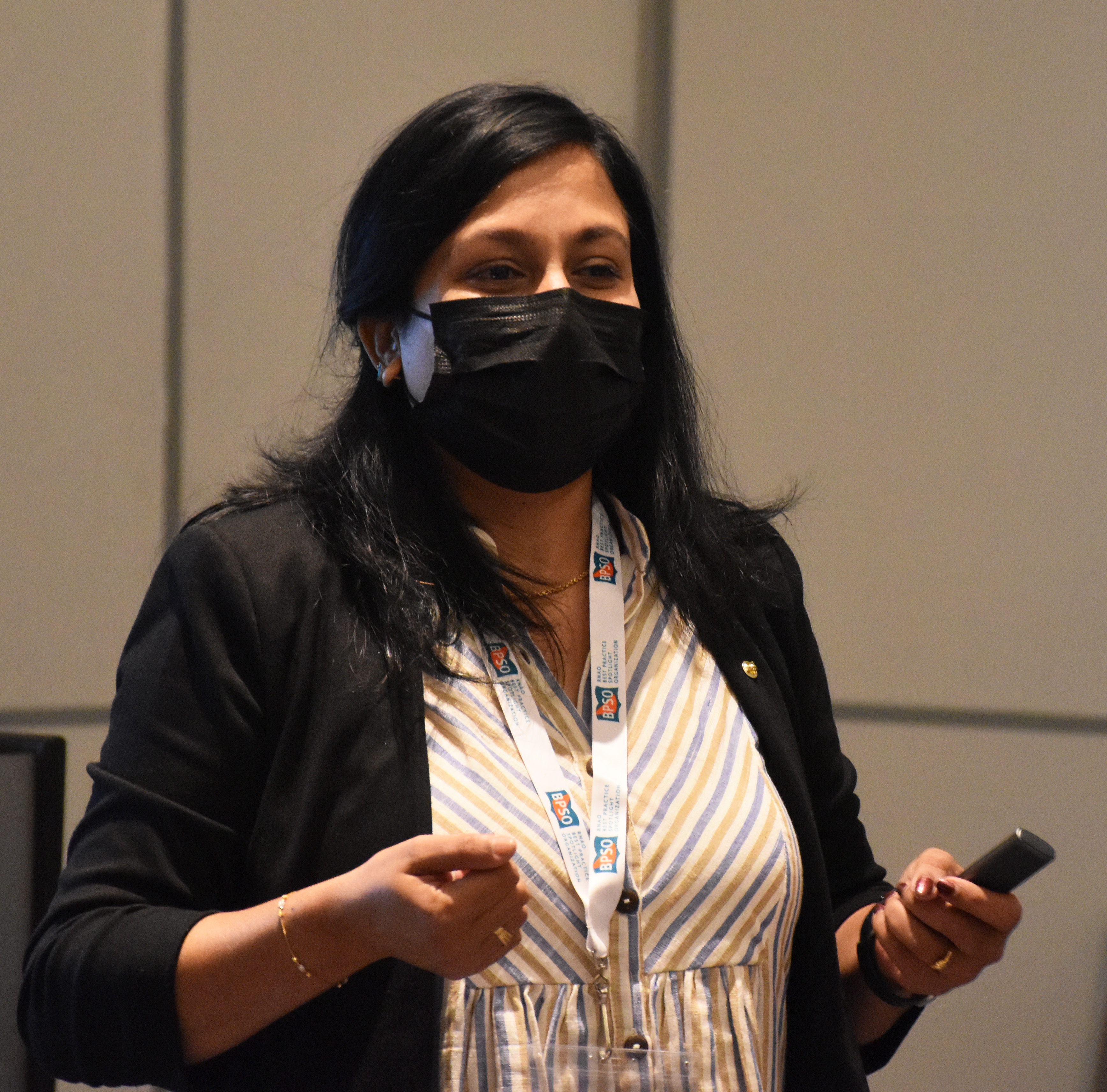
For Ann Roberts, a nurse of 35 years, being a best practice guideline (BPG) champion is about doing something that is “meaningful.” BPGs are incredibly meaningful because they’re having an impact, the Montfort Hospital palliative care RN says.
A self-described “product” of Best Practice Spotlight Organization® (BPSO®) culture (she stepped into her role at the hospital when BPGs were already being implemented), Roberts talks fondly of both the anecdotal impact of BPGs and the impact obtained from the data. You can’t have one without the other, she noted during a panel discussion in Toronto this fall.
Roberts was one of seven panelists taking part in a discussion about the outcomes of BPG implementation during RNAO’s 18th annual BPSO Symposium in September. At Montfort – which has expanded its BPSO Direct role to also act as Specialty Host for Francophone BPSOs and a BPSO OHT (Ontario Health Team) – the
culture of evidence-based practice and its link to better patient outcomes is so ingrained that Roberts, who is a BPSO lead for the organization, no longer finds herself looking for champions. The champions find her.
In one recent case, she received an email from a concerned nurse who had just come off a particularly boisterous night shift feeling really horrible that one of the patients on the unit was at the end of her life while the nurses were laughing and unaware at the nursing station. She wanted to right the wrong, and together with Roberts, created a new initiative to identify the rooms of patients at the end of their life with a large blue butterfly on the door. The initiative aligns with recommendations in RNAO’s Person- and Family-Centred Care BPG, one of 11 BPGs that are being implemented at the hospital.
“So simple, but so impactful,” Roberts says of the idea that came from a “self identified champion” who didn’t hold the formal title, but was eager to apply evidence to address a gap in person- and family-centred care.
(Above) Montfort Hospital palliative care RN Ann Roberts was one of seven panelists taking part in a discussion about the outcomes of BPG implementation during the BPSO Symposium in Toronto in September 2023.
You can do all the implementation and innovation you want as a BPSO, but without hard data to show your efforts are making a difference, you won’t be able to build on your success and continue to see positive outcomes.
This is an example of the anecdotal impact of BPGs on nursing practice, and examples like this are playing out in BPSOs across all sectors. These stories are the fabric and narrative of the BPSO movement. And while they are shared for inspiration at annual BPSO knowledge events and gatherings, another narrative is also playing out simultaneously. It comes in the form of numbers and hard facts – just what researchers, including statisticians, need to show without a doubt that BPGs are making a tangible difference to patient outcomes and health-care workplaces the world over.
“You can do all the implementation and innovation you want as a BPSO, but without hard data to show your efforts are making a difference, you won’t be able to build on your success and continue to see positive outcomes,” says Dr. Shanoja Naik, RNAO’s lead scientist.
Monitoring and evaluating the impact of BPG implementation – the third of the BPG program’s three guiding pillars – enables BPSOs to track their progress, identify areas for improvement, and even predict patterns in BPG-related outcomes.
Launched in 2012, RNAO’s Nursing Quality Indicators for Reporting and Evaluation® (NQuIRE®) data system collects data from quality indicators derived from the recommendations in RNAO’s BPGs. This allows BPSOs in Ontario and around the world to track their progress, identify areas for improvement, invest further and advance quality improvement. Monitoring and evaluating these indicators became mandatory for all BPSOs almost 10 years ago. And the results are reflected in a growing body of research and academic publications, including RNAO Evidence Boosters, which offer infographics that shine a spotlight on BPSOs.
For champions and change agents, the compelling and relatable stories that colleagues like Roberts share at symposiums and other BPSO events provide the inspiration to propel a continued push for evidence-based practice. And for administrators and decision-makers who handle the purse strings for many initiatives, the data is the bread and butter. It’s this information that justifies the spending and clearly shows a need to continue the work.
“The data we collect shows the enormously positive impact the BPGs and BPSO program are having on patients, nurses and other health providers, organizations and health systems as a whole,” says RNAO CEO Dr. Doris Grinspun. “It informs where and how BPGs are enhancing nursing practice and patient outcomes, which leads to better organizational and health system performance and ultimately better allocation of resources to support evidence-based practice.”
Let’s take a look at some of the most recent data, collected from different sectors and published in RNAO Evidence Boosters:
The Hamilton, Niagara, Haldimand, Brant (HNHB) Behavioural Supports Ontario (BSO) team enhances health services for older adults at 86 Ontario long-term care homes by providing non-pharmacological recommendations for residents with dementia, mental-health issues, substance-use disorders or other neurological conditions. As a BPSO, HNHB BSO began implementing RNAO’s Person- and Family-Centred Care BPG in the spring of 2020.
Details of its success were published in an Evidence Booster in late 2021, outlining the hard numbers that show the five sites involved in BPG implementation saw a dramatic increase in satisfaction among residents and their families when involved in their own care and treatment plans. Within three months of implementing recommendations from the BPG, one site saw a 50 per cent increase in participation of residents and family members in developing their personalized care plans. Responses from a survey of all five implementation sites show an 80 per cent increase in resident and family member satisfaction with their involvement.
Hospital del Trabajador specializes in the treatment of trauma, burns, occupational health and rehab services for adults in Santiago, Chile. As a BPSO, it began implementing the Assessment and Management of Pressure Injuries for the Interprofessional Team BPG in 2020. Thanks to the creation of standardized practices across the organization, based on the BPG recommendations, the hospital saw a seven per cent relative decrease in the percentage of people who developed one or more new pressure injuries during their stay. According to an Evidence Booster published in October 2023, the percentage of persons who received a risk assessment for developing pressure injuries increased from 69 to 100 per cent in 2022.
In 2018, Nipissing University in North Bay began incorporating BPGs into its nursing curriculum. Specifically, it implemented the Person- and Family-Centred Care, Preventing Falls and Reducing Injury from Falls, and Engaging Clients Who Use Substances BPGs into all of its direct and blended learning nursing programs for more than 1,700 students combined. By May 2022, the results of a survey of students was published in an Evidence Booster that revealed increases of 18, 38 and 19 per cent (respectively) in the number of students who were “very” or “extremely” familiar with recommendations in the three BPGs (noted above). When asked about implementing those recommendations at the bedside during clinical courses and on placements, the survey showed increases of 36, 25 and 19 per cent (respectively) in the number of students who were implementing recommendations “most of the time” or “always.”
Preliminary outcomes in home and community care
At the panel discussion in Toronto in September, two BPSO leads representing VHA Home Healthcare – which serves clients in Toronto, London, as well as the Durham and Champlain regions – joined Roberts and others to share some preliminary outcomes from the implementation of the Assessment and Care for Adults at Risk of Suicidal Ideation and Behaviour clinical BPG (a new edition will be released in 2024) as well as the healthy work environment BPG focused on Preventing Violence, Harassment and Bullying Against Health Workers.
Banu Sundaralingam is an occupational therapist and BPSO lead on the interdisciplinary team focused on suicide prevention.
Their work to date has “…truly only scratched the surface on suicide prevention in the community. There is much more work to be done,” she says. Despite this, Sundaralingam is pleased to see what the data is saying to date.
A survey of staff pre-implementation showed the need for more training and a lack of confidence among providers in assessing clients at imminent risk of suicide. As a result, a suicide prevention champions committee was formed to focus on four things: updating VHA’s suicide prevention policy; creating discipline-specific crisis intervention processes to manage clients at risk; creating a suicide prevention education e-module; and creating accessible resources for staff to use in practice.
The team collected data from 2021 to 2023 and found there was a 44 per cent increase in suicide risk reports by staff, and a higher awareness of how to identify and report risk. A survey post-implementation showed a 56 per cent increase in the confidence of staff to assess and provide the necessary supports. “We’re really thankful for this opportunity to implement the BPG…because we were able to raise awareness of the importance of suicide prevention and advocating for improved practices at VHA.”
Adam Benn, VHA’s director of equity, diversity and inclusion, and the BPSO lead working towards the prevention of harassment and violence in the workplace, also shared findings, specifically related to a 32-week pilot project to increase reporting of violence and harassment towards PSWs, the largest portion of their workforce.
After one year of implementation, BPGs produce outcomes and we know the science is strong.
“We asked workers to report everything,” he said. “If it happened, we wanted to hear about it.” During the pilot, almost a quarter of PSWs reported incidents they would not have traditionally reported. Of these, more than half offered up client-specific strategies to address the violence, and these strategies were shared with others. Forty incidents were reported, and two were escalated when it was determined there were trends in the reporting.
“For me…the biggest thing is to get staff to more comfortably identify violence and harassment,” Benn said. “Once we get that data, we can go (to management) and say this is the percentage of staff experiencing this, and we have accurate numbers. Then we can push for larger changes in the sector.”
“It is inspiring to see that when BPSOs measure outcomes on any of RNAO’s clinical or healthy work environment BPGs, the data tells a powering story of just how significantly evidence-based practice is making a marked difference,” Grinspun says. “After one year of implementation, BPGs produce outcomes and we know the science is strong. Sharing these outcomes internally with staff and externally through publications and research papers is energizing and validates nurses and other health providers, as well as their organizations. They feel recognized for their efforts and commitment to excellence in patient care. This in turn reinforces person-centred, evidence-based practices on a continuous basis, moving all from strength to even greater strength.”
Find out more about NQuIRE and the work of RNAO’s research unit, including projects on artificial intelligence and machine learning, online.
Strong and credible data needs a strong and credible team
In order to ensure the integrity of its Nursing Quality Indicators for Reporting and Evaluation® (NQuIRE®) data system, RNAO established an advisory team with experts from health and academic organizations across North America and abroad. The NQuIRE International Advisory Council (IAC) was launched in 2012, the same year NQuIRE began collecting data from BPSOs. Its team of experts has been providing oversight and advice ever since.
The 14 IAC members include co-chairs Dr. Doris Grinspun, RNAO CEO, and Dr. John Lavis, director of McMaster University Health Forum, plus representatives from the World Health Organization, Canadian Institute for Health Information, Ontario Health and research innovators from Amsterdam, Spain and the U.S.
The group, which meets twice each year, gathered at RNAO home office in June 2023 to discuss progress and advise on next steps for the NQuIRE data system, new data features and innovations, as well as BPG developments, RNAO clinical pathways, and so much more. Input from council members informs and supports innovation and emerging opportunities, identifies areas for growth, and allows for discussion of improvements to data architecture and methods of analysis.
Find out more about the IAC and its work online.

In late June 2023, IAC members met in person at RNAO home office to discuss next steps for NQuIRE, new data features and innovations, BPG developments, RNAO clinical pathways, and more.
Want to learn more about artificial intelligence (AI) and machine learning?
Late last year, RNJ published an article about AI and BPSOs, raising questions and excitement about this new frontier for evidence-based practice. Read the article, BPG Corner: Using emerging technologies to reach new frontiers in evidence-based nursing.
In 2020, RNAO issued an urgent call for nurses to engage in shaping and influencing the future of AI health technologies. The association released Nursing and Compassionate Care in the Age of Artificial Intelligence, a report with 15 recommendations, eight of which called for immediate action to establish a strong foundation upon which the remaining recommendations would be built.
The aim for the report recommendations, developed by RNAO and AMS Healthcare, was twofold: to prepare nurses and nursing students to leverage AI to augment the patient experience and outcomes; and to successfully integrate emerging AI technologies into the nursing profession. Find out more about the report in the RNJ article, Building tomorrow.



